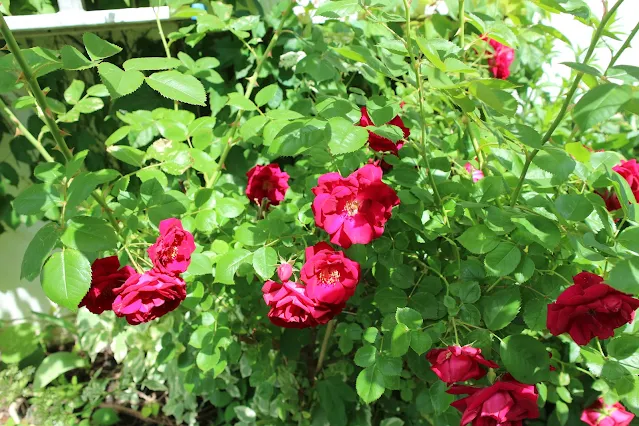 |
| These three photographs were taken in July 2021. |
Then, a few years ago, I began to work on the backyard garden and I called it a Canadian cottage garden as distinct from the much loved English country garden. I noticed that the two rose bushes, planted by the previous owner, were still alive; I bought and planted a third rose bush even though I've never had much luck with roses. I am not, I guess, a rose person... Early last spring, 2021, one of the two original rose buses looked as though it had died; I tried to dig it up but I was lazy and gave up on it; that rose bush was more tenacious than I realized. For a few weeks the two surviving rose bushes thrived, I've never had so many roses! Then, one day, I noticed a neighbour's roses, they were incredibly abundant and remained so all summer and, even yesterday, they had flowers although now covered with the first frost of the season. My roses lasted a few weeks, died, and that was the end of them; my neighbour's roses bloomed all summer and fall. Looking at the photographs of my roses leaves me wondering what kind of roses they are. A couple of weeks ago, I noticed that the rose bush I thought had died was still alive, it had survived the previous winter, it had survived my neglect. Well, what do you know? All three rose bushes are now alive; I will wrap them with burlap for the winter and look after them better in the future.
Here is part of a longer quotation from Karl Ove Knausgaard's novel, Autumn, in which he mentions the regenerative power of nature: "Life is so robust, it seems to come cascading, blind and green, and at times it is frightening." Written after he hacked away at an apple tree, then was concerned that he might have killed the tree, and a few months later had more apples than ever before. Despite everything, nature affirms life. And this is one of the things that gives me hope, no matter what terrible things people do to the world, to Earth, nature will soon return and reclaim what we have leveled, built on, destroyed, polluted, and desecrated.
 |
| These three photographs were take in July 2020, also an excellent garden summer. |









